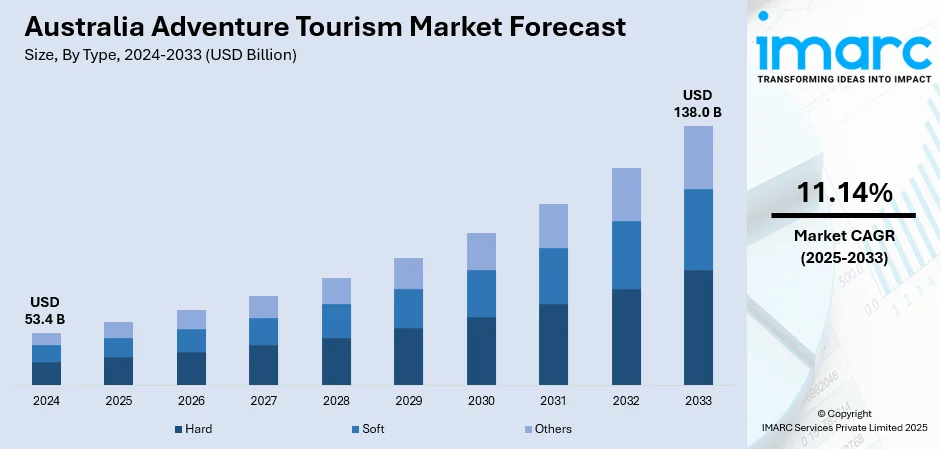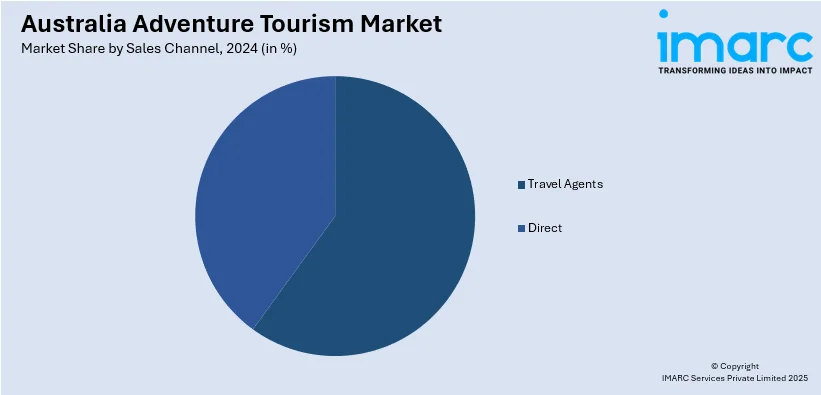
Australia Adventure Tourism Market Report by Type (Hard, Soft, and Others), Activity (Land-Based Activity, Water-Based Activity, Air-Based Activity), Type of Traveler (Solo, Friends/Group, Couple, Family), Age Group (Below 30 Years, 30-41 Years, 42-49 Years, 50 Years and Above), Sales Channel (Travel Agents, Direct), and Region 2025-2033
Australia Adventure Tourism Market Overview:
The Australia adventure tourism market size reached USD 53.4 Billion in 2024. Looking forward, the market is projected to reach USD 138.0 Billion by 2033, exhibiting a growth rate (CAGR) of 11.14% during 2025-2033. The market is experiencing steady growth driven by an enhanced focus on improving transportation infrastructure, the presence of diverse natural landscapes in the country, and robust government support to offer varied activities across unique ecosystems and ensure high safety and quality standards.
|
Report Attribute
|
Key Statistics
|
|---|---|
|
Base Year
|
2024
|
|
Forecast Years
|
2025-2033
|
|
Historical Years
|
2019-2024
|
| Market Size in 2024 | USD 53.4 Billion |
| Market Forecast in 2033 | USD 138.0 Billion |
| Market Growth Rate 2025-2033 | 11.14% |
Key Trends of Australia Adventure Tourism Market:
Enhanced accessibility and transport infrastructure
The ongoing advancements in Australia's transportation sector, along with increased accessibility, are exerting a positive influence on the adventure tourism market. Government initiatives aimed at improving highways and enhancing regional air transport links are facilitating access to remote areas for both domestic and international tourists. For example, the introduction of direct international flights to cities such as Cairns—renowned for its proximity to the Great Barrier Reef and rainforests—has led to an increased influx of adventure seekers. Improved connections result in shorter travel durations and decreased expenses, leading to a more efficient and cost-effective travel experience. These logistical improvements effectively lower the barriers to regions previously considered inaccessible, thereby expanding the scope for adventure-related experiences and resulting in market growth.

To get more information on this market, Request Sample
Growing popularity of Australia’s diverse natural landscapes
The rising appeal of Australia's varied natural scenery plays a major role in driving the country's adventure tourism industry. Australia's distinctive landscape, featuring diverse natural elements like pristine beaches, lush rainforests, rugged mountains, and vast deserts, draws an increasing number of thrill-seekers from all over the world. The variety of landscapes enables a wide selection of activities like bushwalking, scuba diving, surfing, and rock climbing, catering to different preferences and levels of expertise. The increasing popularity of experiential travel, in which travelers look for engaging and hands-on experiences, matches well with Australia's adventure opportunities. Due to the country's varied terrains and continuous initiatives to protect and showcase these regions, they are the main catalyst for the expansion of their adventure tourism industry.
Government and industry support
The Australian government is working with different tourism boards to promote adventure tourism through focused marketing campaigns and partnerships with local businesses. Efforts highlight the wide array of adventure activities offered, effectively establishing Australia as a top adventure spot. Government support and financial aid for small businesses in tourism enhances the standard and security of adventure activities offered. This support is helping to establish a robust adventure tourism network, with certified guides and outfitters adhering to global safety standards. This professionalized service gives confidence to prospective tourists, ensuring a secure and satisfying trip, therefore providing a boost to market expansion.
Growth Drivers of Australia Adventure Tourism Market:
Rising International Arrivals
The Australia adventure tourism market demand experiences notable growth due to the continuous increase in international tourist arrivals. Visitors from the Asia-Pacific region, Europe, and North America are attracted to Australia’s extraordinary landscapes, including the Great Barrier Reef, Blue Mountains, and Outback deserts, which provide a variety of adventure experiences. The nation’s strong reputation for safety, advanced infrastructure, and high-quality tourism services further boosts its allure on the global stage. Tourists are also driven by the quest for unique experiences such as diving, trekking, and wildlife interactions, which are plentiful in Australia. This surge in global visitors significantly benefits local businesses, raises tourism revenue, and fuels ongoing growth in the sector. The escalating number of arrivals plays a crucial role in enhancing the Australia adventure tourism market share.
Adventure Sports Popularity
Adventure sports have become a key element in shaping the future landscape of the Australian tourism industry. With its extensive coastline, Australia has established itself as a hub for surfing and scuba diving, while its expansive terrains are perfect for activities like trekking, hiking, and skydiving. Both international and domestic travelers are increasingly seeking high-energy experiences that merge leisure with challenges, creating ample opportunities for operators to broaden their offerings. Seasonal events, sports competitions, and marketing initiatives further promote participation. This rising enthusiasm boosts tourism expenditure and attracts investments in specialized facilities and training programs. By accommodating a range of skill levels from novices to experts Australia consistently draws a diverse array of adventure lovers, fostering ongoing Australia adventure tourism market growth.
Domestic Tourism Growth
The growth of adventure tourism in Australia is significantly influenced by international visitors and the local population. A rising number of Australians are engaging in adventure activities such as camping, mountain biking, diving, and eco-tourism within their own locales. Increased awareness about health benefits, the affordability of local travel, and the provision of safe, well-organized adventure options motivate greater involvement. This trend minimizes reliance on foreign tourists while ensuring market stability throughout the year. Local marketing efforts and infrastructure development initiatives also significantly contribute to fostering interest among residents. According to Australia adventure tourism market analysis, the active participation of domestic travelers helps maintain steady growth momentum in the market, enhancing both demand and sustainability.
Australia Adventure Tourism Market Segmentation:
IMARC Group provides an analysis of the key trends in each segment of the market, along with forecasts at the regional and country levels for 2025-2033. Our report has categorized the market based on type, activity, type of traveler, age group, and sales channel.
Type Insights:
- Hard
- Soft
- Others
The report has provided a detailed breakup and analysis of the market based on the Type. This includes hard, soft, and others.
Activity Insights:
- Land-Based Activity
- Water-Based Activity
- Air-Based Activity
A detailed breakup and analysis of the market based on the Activity have also been provided in the report. This includes land-based activity, water-based activity, and air-based activity.
Type of Traveler Insights:
- Solo
- Friends/Group
- Couple
- Family
The report has provided a detailed breakup and analysis of the market based on the Type of Traveler. This includes solo, friends/group, couple, and family.
Age Group Insights:
- Below 30 Years
- 30-41 Years
- 42-49 Years
- 50 Years and Above
A detailed breakup and analysis of the market based on the Age Group have also been provided in the report. This includes below 30 years, 30-41 years, 42-49 years, and 50 years and above.
Sales Channel Insights:

- Travel Agents
- Direct
The report has provided a detailed breakup and analysis of the market based on the Sales Channel. This includes travel agents, and direct.
Regional Insights:
- Australia Capital Territory & New South Wales
- Victoria & Tasmania
- Queensland
- Northern Territory & Southern Australia
- Western Australia
The report has also provided a comprehensive analysis of all the major regional markets, which include Australia Capital Territory & New South Wales, Victoria & Tasmania, Queensland, Northern Territory & Southern Australia, and Western Australia.
Competitive Landscape:
The market research report has also provided a comprehensive analysis of the competitive landscape. Competitive analysis such as market structure, key player positioning, top winning strategies, competitive dashboard, and company evaluation quadrant has been covered in the report. Also, detailed profiles of all major companies have been provided.
Australia Adventure Tourism Market News:
- June 29, 2023: Tourism Adventure Group (TAG) has completed its acquisition of the Work and Travel Company, a significant player in providing work and travel opportunities for young travelers. This strategic move, reported in June 2023, allows TAG to expand its portfolio of services by integrating the offerings of the Work and Travel Company, which specializes in arranging working holidays, job placements, and travel experiences primarily in Australia.
Australia Adventure Tourism Market Report Coverage:
| Report Features | Details |
|---|---|
| Base Year of the Analysis | 2024 |
| Historical Period | 2019-2024 |
| Forecast Period | 2025-2033 |
| Units | Billion USD |
| Scope of the Report | Exploration of Historical Trends and Market Outlook, Industry Catalysts and Challenges, Segment-Wise Historical and Future Market Assessment:
|
| Types Covered | Hard, Soft, Others |
| Activities Covered | Land-Based Activity, Water-Based Activity, Air-Based Activity |
| Type of Travelers Covered | Solo, Friends/Group, Couple, Family |
| Age Groups Covered | Below 30 Years, 30-41 Years, 42-49 Years, 50 Years and Above |
| Sales Channels Covered | Travel Agents, Direct |
| Regions Covered | Australia Capital Territory & New South Wales, Victoria & Tasmania, Queensland, Northern Territory & Southern Australia, Western Australia |
| Customization Scope | 10% Free Customization |
| Post-Sale Analyst Support | 10-12 Weeks |
| Delivery Format | PDF and Excel through Email (We can also provide the editable version of the report in PPT/Word format on special request) |
Key Benefits for Stakeholders:
- IMARC’s industry report offers a comprehensive quantitative analysis of various market segments, historical and current market trends, market forecasts, and dynamics of the Australia adventure tourism market from 2019-2033.
- The research report provides the latest information on the market drivers, challenges, and opportunities in the Australia adventure tourism market.
- Porter's five forces analysis assist stakeholders in assessing the impact of new entrants, competitive rivalry, supplier power, buyer power, and the threat of substitution. It helps stakeholders to analyze the level of competition within the Australia adventure tourism industry and its attractiveness.
- Competitive landscape allows stakeholders to understand their competitive environment and provides an insight into the current positions of key players in the market.
Key Questions Answered in This Report
The adventure tourism market in Australia was valued at USD 53.4 Billion in 2024.
The Australia adventure tourism market is projected to exhibit a compound annual growth rate (CAGR) of 11.14% during 2025-2033.
The Australia adventure tourism market is expected to reach a value of USD 138.0 Billion by 2033.
The Australia adventure tourism market is witnessing trends such as increasing demand for eco-friendly and sustainable travel, rising digital booking platforms, and customized adventure packages. Growing popularity of wellness-focused adventures, cultural immersion experiences, and adventure sports events also shape market expansion, attracting both domestic and global travelers.
The Australia adventure tourism market is driven by diverse landscapes, strong international tourist inflows, and rising domestic participation in outdoor activities. Government promotion of tourism, growing interest in adventure sports, and increasing demand for unique travel experiences further support growth, positioning Australia as a global hub for adventure tourism.
Need more help?
- Speak to our experienced analysts for insights on the current market scenarios.
- Include additional segments and countries to customize the report as per your requirement.
- Gain an unparalleled competitive advantage in your domain by understanding how to utilize the report and positively impacting your operations and revenue.
- For further assistance, please connect with our analysts.
 Request Customization
Request Customization
 Speak to an Analyst
Speak to an Analyst
 Request Brochure
Request Brochure
 Inquire Before Buying
Inquire Before Buying




.webp)




.webp)












